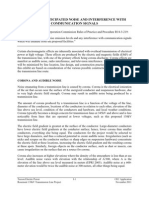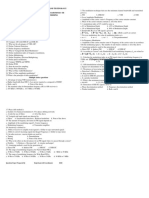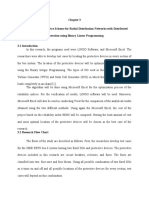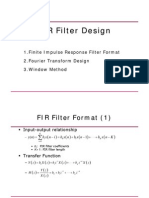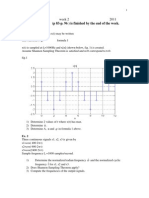Assignment DSP 1
Uploaded by
vankhoakmtAssignment DSP 1
Uploaded by
vankhoakmtDigital Signal Processing Assignment 1
Allowed time: 120 minutes
Prob. 1: The signal x(t) = cos(5t) + 4 sin(2t)sin(3t), where t is in milliseconds, is sampled at a rate of 3 kHz. Determine the signal xa(t) aliased with x(t). Determine two other signals x1(t) and x2(t) that are different from each other and from x(t), yet they are aliased with the same xa(t) that you found. Prob. 2: Consider the periodic triangular waveform with period T0 = 1 sec shown below. The waveform is sampled at rate fS = 8 Hz and the resulting samples are reconstructed by an ideal reconstructor. Show that the signal xrec(t) that will appear at the output of the reconstructor will have the form: xrec(t)= Asin(2f1t) + Bsin(2f2t) and determine the numerical values of the frequencies f1, f2 and amplitudes A, B.
Prob. 3: Consider the following sound wave, where t is in milliseconds: x(t) = sin(10t) + sin(20t) + sin(60t) + sin(90t) This signal is prefiltered by an analog anti-aliasing prefilter H(f) and then sampled at an audio rate of 40 kHz. The resulting samples are immediately reconstructed using an ideal reconstructor. Determine the output ya(t) of the reconstructor in the following cases and compare it with the audible part of x(t): a. When there is no prefilter, that is, H(f) 1. b. When H(f) is an ideal prefilter with cutoff of 20 kHz. c. When H(f) is a practical prefilter that has a flat pass-band up to 20 kHz and attenuates at a rate of dB/octave beyond 20 kHz. (Assume that the effects of the phase response of the filter are ignored.) 48
Prob. 4: Consider a pure sinusoid of frequency f0, x(t)= cos(2f0t). Show that the spectrum of the sampled sinusoid x(nT) is:
Prob. 5: The sinusoidal signal x(t)= sin(2f0t) is sampled at a rate fS and the resulting samples are then reconstructed by an arbitrary analog reconstructing filter H(f). Show that the analog signal at the output of the reconstructor will have the form:
What are the frequencies fm? How are the quantities Am and m related to the frequency response H(f)? Determine the quantities Am and m for the two cases of a staircase reconstructor and an ideal reconstructor. Prob. 6: Prove the Fourier series expansion of the ideal sampling function s(t) given below. Then, prove its Fourier transform expression S(f).
Please do your assignment in english. Good luck!
You might also like
- EE321 - Assignment #1 - Noise, SNR, and Power Spectral DensityNo ratings yetEE321 - Assignment #1 - Noise, SNR, and Power Spectral Density3 pages
- Module 02 Generator and Transformer Models - With NotesNo ratings yetModule 02 Generator and Transformer Models - With Notes39 pages
- Study and Analysis of Double-Line-To-Ground FaultNo ratings yetStudy and Analysis of Double-Line-To-Ground Fault5 pages
- 1 Metallic Cable Transmission Media by Engr. Richard FigueroaNo ratings yet1 Metallic Cable Transmission Media by Engr. Richard Figueroa32 pages
- Analysis and Design of Transmission Line Structures by Means of The Geometric Mean Distance - IEEENo ratings yetAnalysis and Design of Transmission Line Structures by Means of The Geometric Mean Distance - IEEE4 pages
- Condition Monitoring of Electrical Cables Using Line Resonance AnalysisNo ratings yetCondition Monitoring of Electrical Cables Using Line Resonance Analysis6 pages
- Communication Suggestion For EEE Job Preparation50% (2)Communication Suggestion For EEE Job Preparation19 pages
- Exhibit I Anticipated Noise and Interference With Communication SignalsNo ratings yetExhibit I Anticipated Noise and Interference With Communication Signals4 pages
- Example: A Three Phase Overhead Lines Has A Resistance & Reactance ofNo ratings yetExample: A Three Phase Overhead Lines Has A Resistance & Reactance of1 page
- Objective Questions Multiple Choice Questions of High Voltage Engineering (01-15)No ratings yetObjective Questions Multiple Choice Questions of High Voltage Engineering (01-15)4 pages
- POWER SYSTEM ANALYSIS_UNIVERSITY QUESTIONSNo ratings yetPOWER SYSTEM ANALYSIS_UNIVERSITY QUESTIONS92 pages
- Three Phase Fault Analysis With Auto Reset Technology On Temporary Fault or Remain Tripped Otherwise50% (2)Three Phase Fault Analysis With Auto Reset Technology On Temporary Fault or Remain Tripped Otherwise4 pages
- Experiment 2 - Plot of The Annual Load Curve.No ratings yetExperiment 2 - Plot of The Annual Load Curve.6 pages
- Communication Engineering Cycle Test 1 AnNo ratings yetCommunication Engineering Cycle Test 1 An2 pages
- Optimal Protective Device Scheme For Radial Distribution Networks With Distributed Generation Using Binary Linear ProgrammingNo ratings yetOptimal Protective Device Scheme For Radial Distribution Networks With Distributed Generation Using Binary Linear Programming31 pages
- BEE3133 Electrical Power Systems: Transmission Line ParametersNo ratings yetBEE3133 Electrical Power Systems: Transmission Line Parameters84 pages
- Analog-to-Digital and Digital-to-Analog ConversionsNo ratings yetAnalog-to-Digital and Digital-to-Analog Conversions20 pages
- Design and Implementation of FPGA Based Interface Model For Scale-Free Network Using I2C Bus Protocol On Quartus II 6No ratings yetDesign and Implementation of FPGA Based Interface Model For Scale-Free Network Using I2C Bus Protocol On Quartus II 64 pages
- Pham Van Khoa University of Technical EducationNo ratings yetPham Van Khoa University of Technical Education4 pages
























